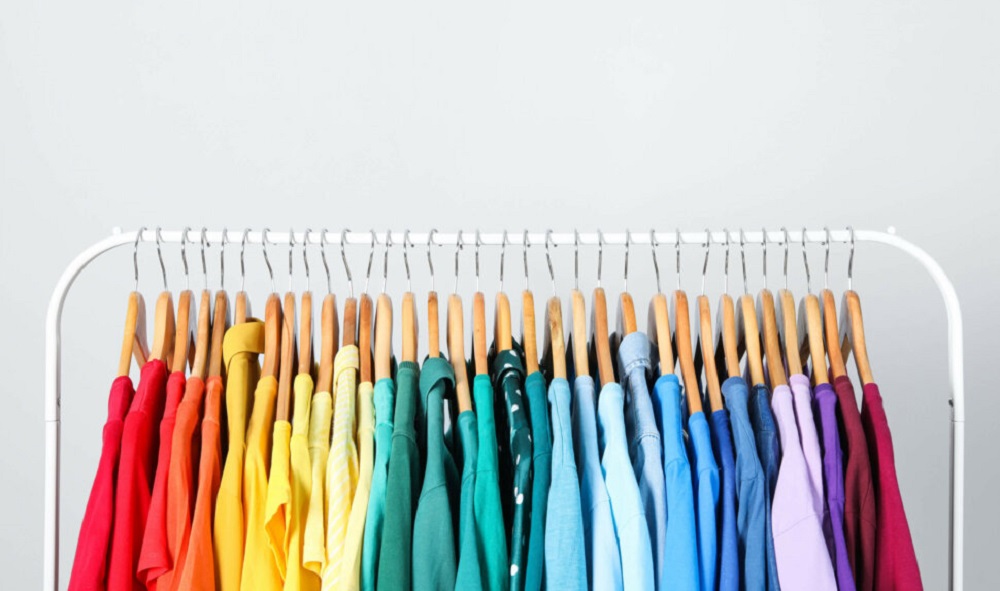
The brick-and-mortar apparel category has faced a unique set of challenges. Two years of a pandemic drastically changed the nature of in-person shopping and gave way to the most significant consumer price index jump in 40 years. Still, the segment had plenty of bright spots – including the five apparel brands featured here.
The Shoes Make The Sector
As previously explored, the shoe category has performed impressively over the past few years, and this continues to be true, especially for one of the fastest-growing chains identified.
Boot Barn, a Western-themed chain that sells both workwear and leisure wear, saw significant growth throughout the past few years, and it doesn’t seem to be slowing down. Visits were up every month since the beginning of 2022, with 7.5% more visitors in August 2022 than in the same period in 2021. The chain has also successfully avoided cannibalization and kept its visits per venue numbers elevated while expanding its store count, with September visits per venue up 2.9% year-over-year (YoY).
Boot Barn has cemented its success by tapping into a traditionally underserved market, establishing itself as not just a destination for cowboy boots but as a Western-themed lifestyle retailer. With Western-style fashions increasing in popularity, the chain’s expansion from the Southwest and West Coast into the Midwest is coming at a great time.
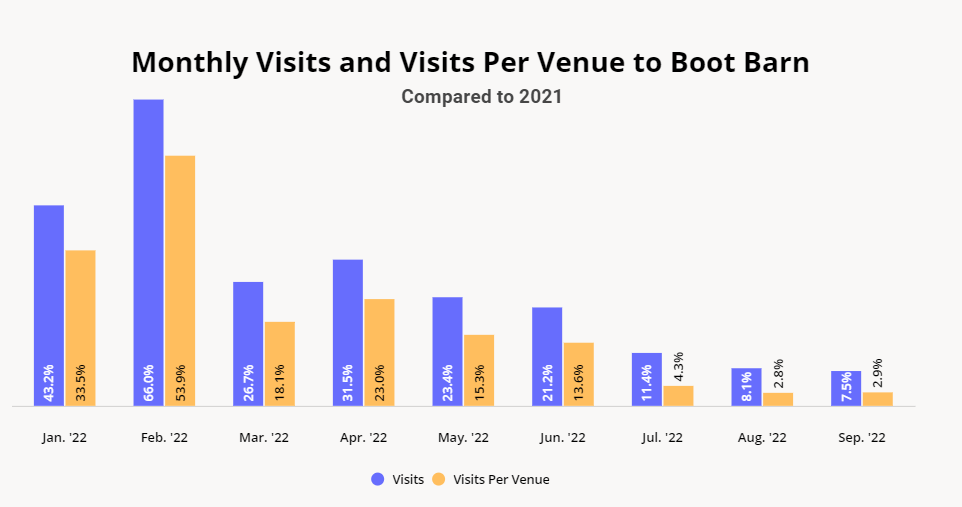
Continued Success for Luxury Department Stores
While many department stores have lagged behind their pre-pandemic visits, luxury retailers have seen elevated visits in recent months. The resurgence of weddings and events may be helping fuel visits to luxury department store Saks Fifth Avenue.
And Sak’s combination of innovative brand partnerships and its focus on customer experience seems to be working, with August and September of 2022 seeing 13.0% and 1.5% more visits to Saks stores than in 2019. And although YoY visits fell slightly beginning in June 2022, the drop should be placed in the context of 2021’s post-lockdown visit surges. The strength of this department store suggests that its customer base may be less affected by inflation and more likely to visit Saks for a wardrobe refresh.
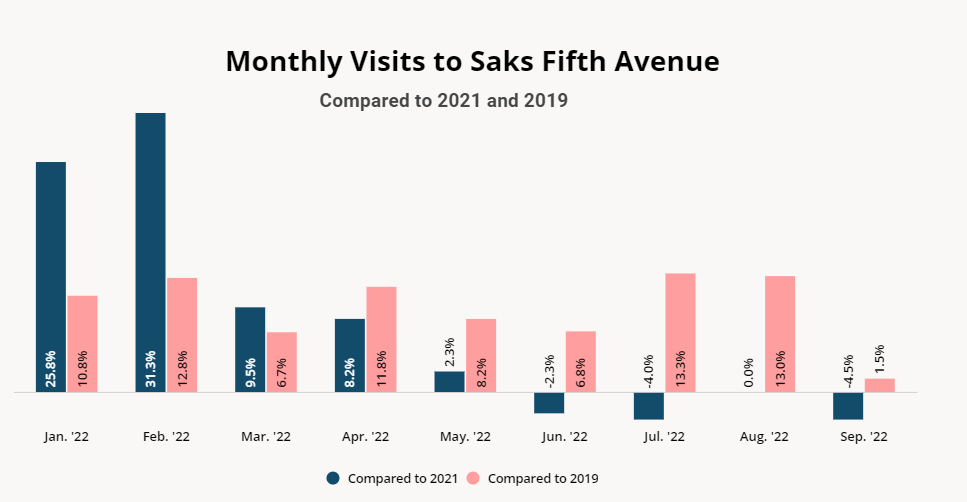
The Thrill of The Bargain Hunt
While Saks Fifth Avenue appeals to a luxury-oriented clientele, Goodwill is a bargain hunter’s dream. The company is an employment-placement program that also sells secondhand clothing, and this combination of activism and affordability makes it a popular choice for many – especially in times of strained consumer budgets.
Recent foot traffic data indicates that Goodwill may be benefitting from apparel consumers’ trading down behavior. Between October 2021 and February 2022, YoY visits increased for both Goodwill and the wider apparel category, with overall apparel YoY foot traffic even exceeding Goodwill YoY visits in November 2021. But since March 2022, the shock of inflation and rising gas prices may be leading consumers to rethink new clothing purchases, which led to a drop in YoY visits to the wider apparel category – while YoY visits to Goodwill remain positive. The thrift shop saw its September visits up 7.5% YoY, while the overall apparel sector was down 8.0%.
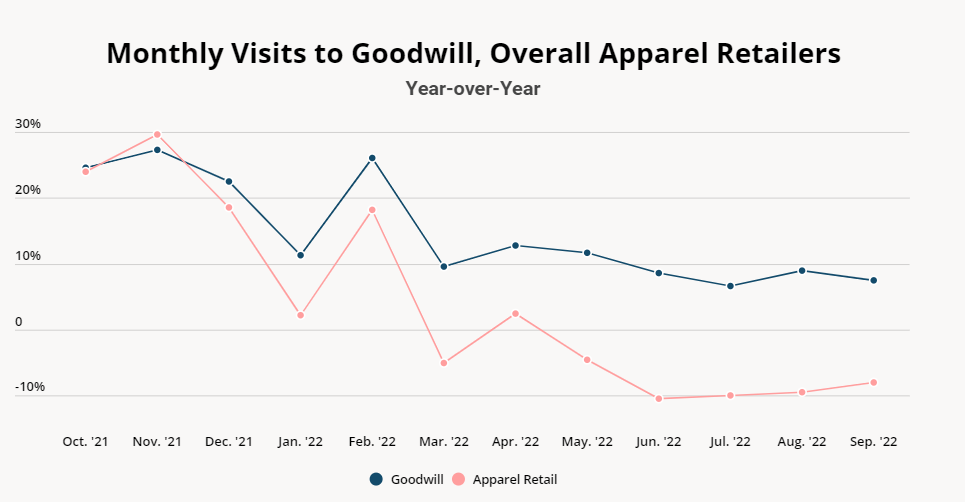
Suiting Up
While Goodwill carries apparel for the whole family, Men’s Wearhouse focuses on all things men’s fashion, an often-overlooked retail segment. Its parent company, Tailored Brands, saw a tumultuous few years, marked by its bankruptcy announcement in 2020, but recently upgraded its standing to a “positive outlook” by the S&P.
Men’s Wearhouse’s foot traffic numbers provide reason for optimism. Visits in April 2022 exceeded 2019 by an impressive 34.2%, and September saw 17.9% growth compared to the same period three years ago, perhaps a result of pent-up demand and postponed weddings. And the Yo3Y increase is even more impressive given that Men’s Wearhouse is now operating with significantly fewer stores – the chain went from 720 locations in 2019 to 634 in 2022, successfully rightsizing in a challenging economic climate. As a result, the brand’s Yo3Y visits per venue growth is outpacing the overall visits increase, with September visits per venue up 32.3% relative to September 2019, meaning that each remaining store is pulling in significantly more customers.

Outdoor Voices Moving Offline
Unlike the other four companies featured here, Outdoor Voices got its start as an online-only DTC company, before opening its first brick-and-mortar store in Austin, TX in 2014. This buzzy, TikTok-viral company is most known for its laid-back approach to athleisure, appealing to a broad range of people. The company now operates 14 stores nationwide, with a Minneapolis and a Philadelphia location on the way. Outdoor Voices has also invested heavily in omnichannel technology to help boost sales both in and out of stores, focusing on BOPIS (buy online, pick up in-store) and same-day delivery.
And despite reportedly contemplating a sale as recession concerns intensify, the brand’s foot traffic has gone up when compared to the beginning of the year, with September visits up 70.4% relative to January 2022.
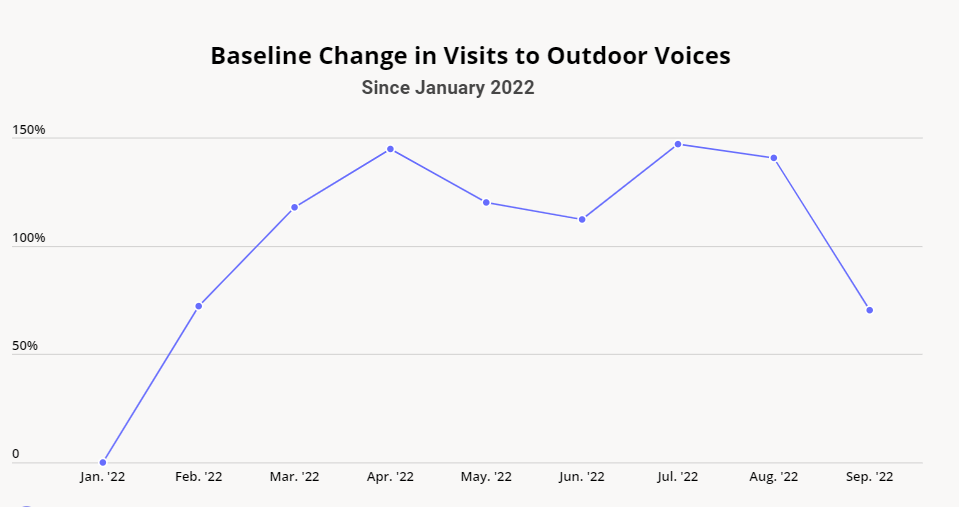
It’s no secret that the past few years have challenged the apparel sector. Still, there are plenty of bright spots, companies successfully rallying in these challenging times, and room for optimism in the months ahead.
To learn more about the data behind this article and what Placer has to offer, visit https://www.placer.ai/.







Sign up to receive our stories in your inbox.
Data is changing the speed of business. Investors, Corporations, and Governments are buying new, differentiated data to gain visibility make better decisions. Don't fall behind. Let us help.













Sign up to receive our stories in your inbox.
Data is changing the speed of business. Investors, Corporations, and Governments are buying new, differentiated data to gain visibility make better decisions. Don't fall behind. Let us help.





